Choosing a buoyancy aid
Choosing a buoyancy aid that suits your kayaking, stand up paddle board (SUP) or canoeing needs is critical to your water safety and paddling fun.
Spending time to ensure that your buoyancy aid fits correctly and provides the best level of buoyancy means you can rely on it when times get tough!
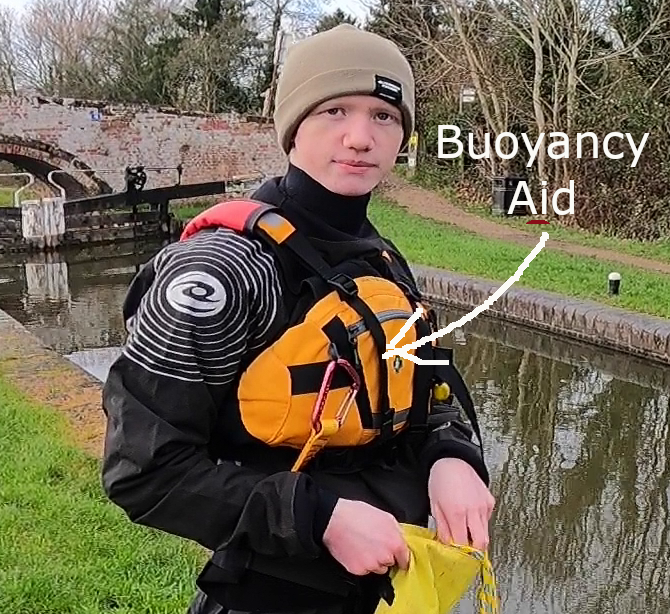 Ed wearing an Astral Serpent 2.0 buoyancy aid with rescue cow tail
Ed wearing an Astral Serpent 2.0 buoyancy aid with rescue cow tailBuoyancy aid or lifejacket? What's the difference?
There is a very important difference between a buoyancy aid and a life jacket - actually given away in the name.
A 'life' jacket is designed to save your life - whether you are conscious or unconscious in the water.
It does this by providing the bulk of the air inflated buoyancy on your front and around your neck. This inflation ensures that your body is facing upwards and your face is out of the water at all times.
You don't need to swim to stay afloat with a life jacket.
A lifejacket is usually worn either fully deflated or partially inflated depending on the requirements. In an emergency, a gas cannister inflates the life jacket.
For kayaking, a life jacket is not recommended. In the event of a capsize, the inflation of a life jacket can pin you against the underside of the kayak making it difficult to exit.
A buoyancy aid, on the other hand, is an aid to your natural buoyancy. It is only useful when you are conscious and makes it easier to swim in the water.
It is worn around the core of the body like an item of clothing. You do need to swim to stay afloat with a buoyancy aid.
The buoyancy provided by a buoyancy aid varies and is measured in newtons. The higher the newtons, the more buoyancy is provided.
Most standard buoyancy aids are 50 newtons - or 50N. 10N is equivalent to 5kg of additional buoyancy.
The terms 'buoyancy aid' and 'life jacket' are often interchanged to mean the same thing - however, as you can see above, they are very different!
When should I wear a buoyancy aid?
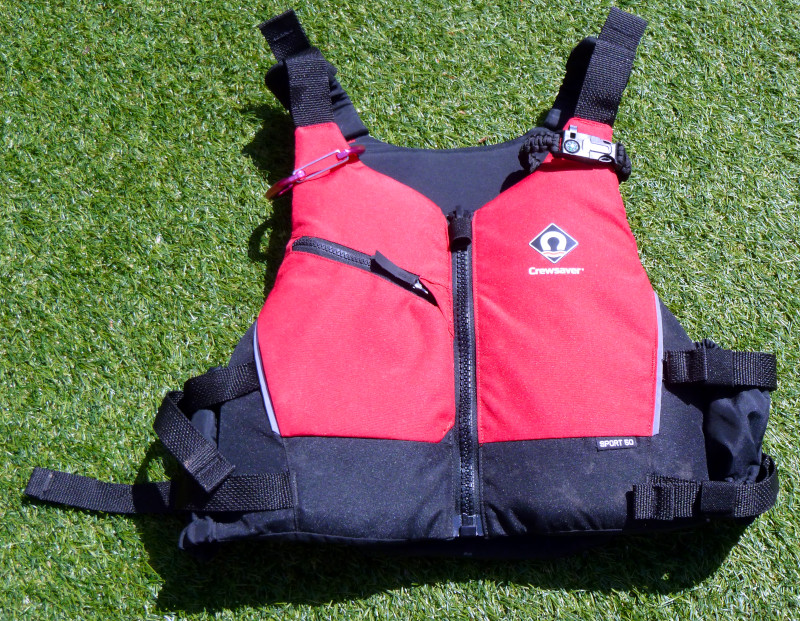 An example of a buoyancy aid
An example of a buoyancy aidAny interaction with water can be dangerous.
From sailing to kayaking, canoeing to fishing - all can present difficult situations.
Because of this, a buoyancy aid (or for certain activities and age groups - a life jacket) should always be worn.
In addition, to use the buoyancy aid effectively, you should be able to swim.
Fitting a buoyancy aid
 Buoyancy aid showing zip and pocket
Buoyancy aid showing zip and pocketWhen wearing a buoyancy aid, it should be fitted correctly.
All zips, straps and clips should be fully engaged and adjusted to provide a tight fit to the body. This avoids any movement when swimming.
Zips often have a secondary lock to avoid the zip coming down during use. These should be locked at all times.
When wearing additional clothing, straps should be loosened to allow for the correct fitting of the buoyancy aid. Equally, when wearing less clothes, the straps should be tightened during each use.
Any damage to the buoyancy aid should be repaired or, in terminal cases, the buoyancy aid replaced.
9 tips for choosing and using your buoyancy aid
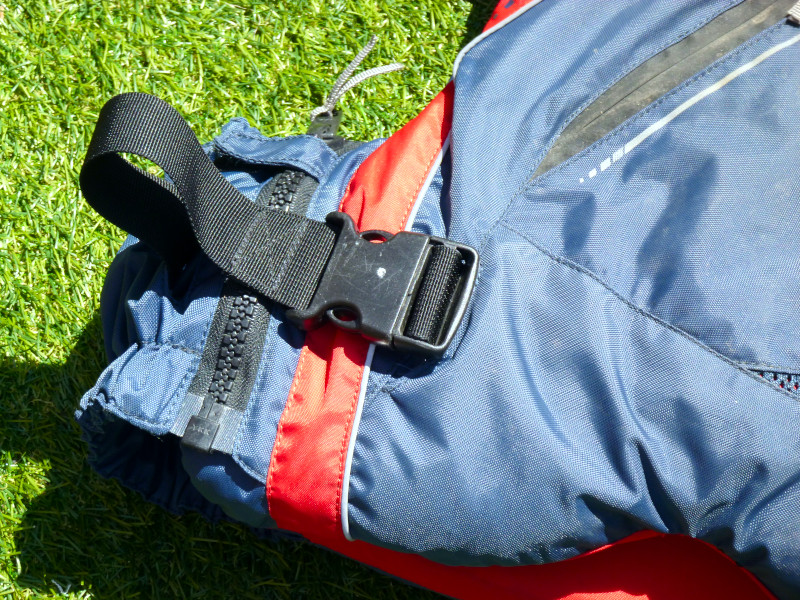 Showing the straps and zip on a buoyancy aid
Showing the straps and zip on a buoyancy aidTip Number 1
Try the buoyancy aid on and check it fits correctly. Move your arms about and test out any restrictions in movement.
If you are using it for kayaking, try it when sitting in your kayak. Make sure it does not ride up too high and obscure your view, movement or exit from the kayak.
Tip Number 2
Make sure the buoyancy aid is certified and labelled with the correct amount of buoyancy for your needs.
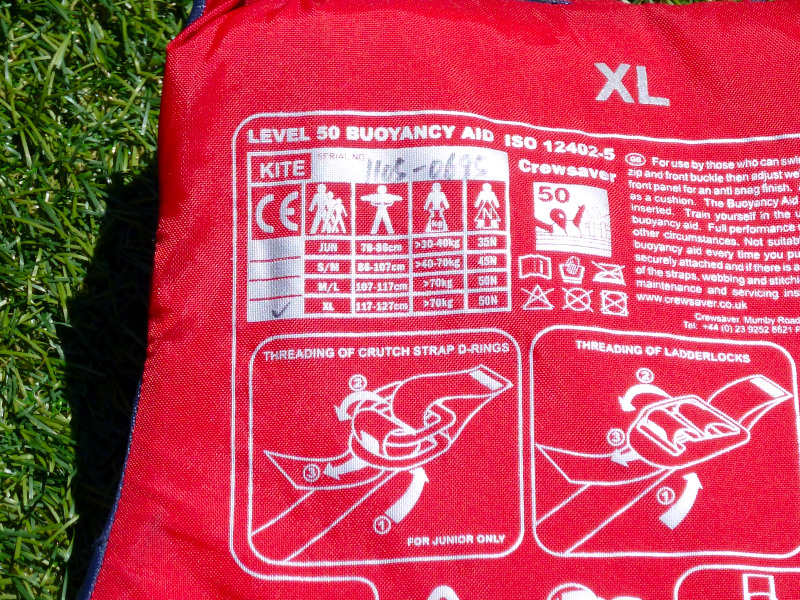 Buoyancy aid marking showing buoyancy rating and certification
Buoyancy aid marking showing buoyancy rating and certificationTip Number 3
Choose a bright colour like red, yellow or orange for your buoyancy aid.
These show up better and make it easier for rescuers to find you in the water.
Tip Number 4
Ensure your buoyancy aid has the correct amount of buoyancy for your needs, intended use and your size.
Tip Number 5
It is useful to have at least one pocket in your buoyancy aid. This can be used for holding keys or other small items.
Tip Number 6
Add a climbing grade karabiner to one or, ideally, both shoulder straps of your buoyancy aid. In an extreme emergency, this provides an anchor point for a throw line (looped through for quick release - never tied!).
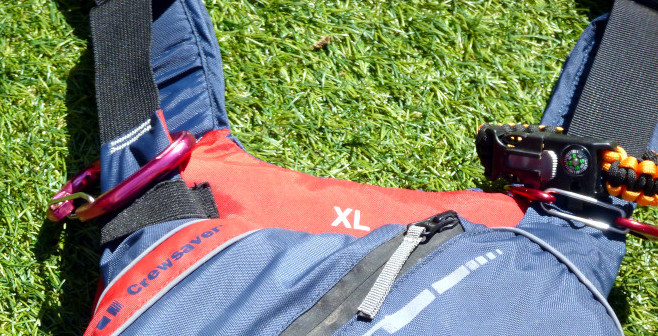 Showing both karabiners and whistle
Showing both karabiners and whistleTip Number 7
Attach a plastic whistle to your buoyancy aid and make sure it is within easy reach. This is an essential piece of equipment on open water and rivers.
Tip Number 8
After use, wash your buoyancy aid in clean water and air dry thoroughly. This protects the internal buoyancy and maximises the life of the buoyancy aid.
Tip Number 9
Practice swimming in your buoyancy aid (not in a swimming pool as this may damage it). Getting the feel of it and working out how much buoyancy it gives you means it will be easier to swim when you actually need to!
Here's Dave's 5 reasons to love your buoyancy aid...
Have fun - and always wear your buoyancy aid!
PS. Paddlesports can be dangerous.
Read our safety disclaimer - here

New paddling inspiration, tip, trip or technique video EVERY week! Watch Ed, Dave and Moo on their kayaking, canoe and SUP adventures. It's all about safely having fun on the water. 200,000+ views, 110+ videos & 900+ subscribers so far! Click below to start watching:
Ed & Dave Kayaking Youtube Channel
WANT TO HELP US?
We really value your visit to us today. We run this website and our Youtube channel to provide paddling inspiration, tips, trip and technique content to you. We love being out on the water! If you enjoyed your visit, you can support us by using the links below:
Buy us something on our wish list
Thank you
NEED WEB HOSTING?
We recommend IONOS. Great service, technical support and stable hosting. Click the link below to find out more:
IONOS Web Hosting - RECOMMENDED!



